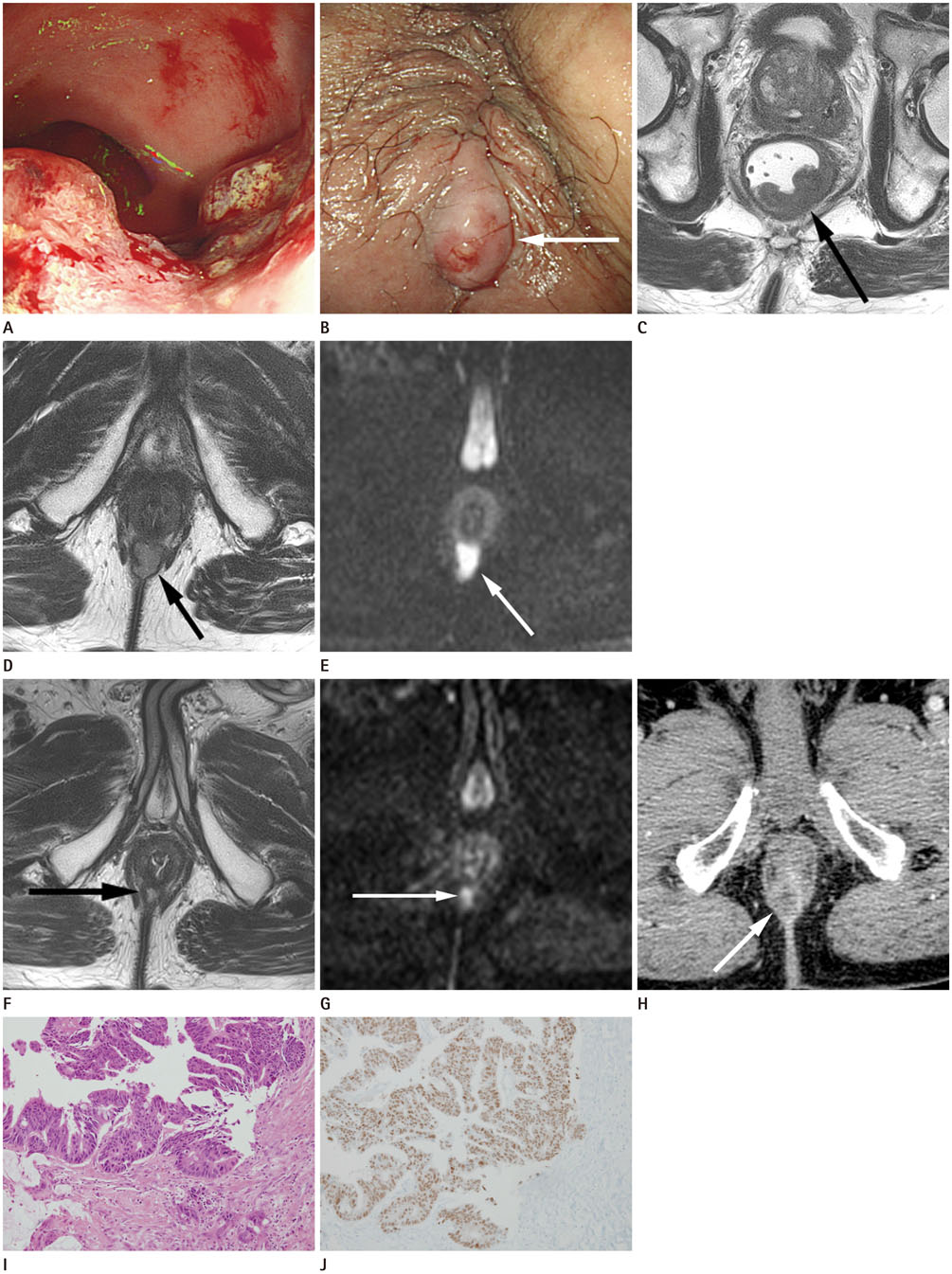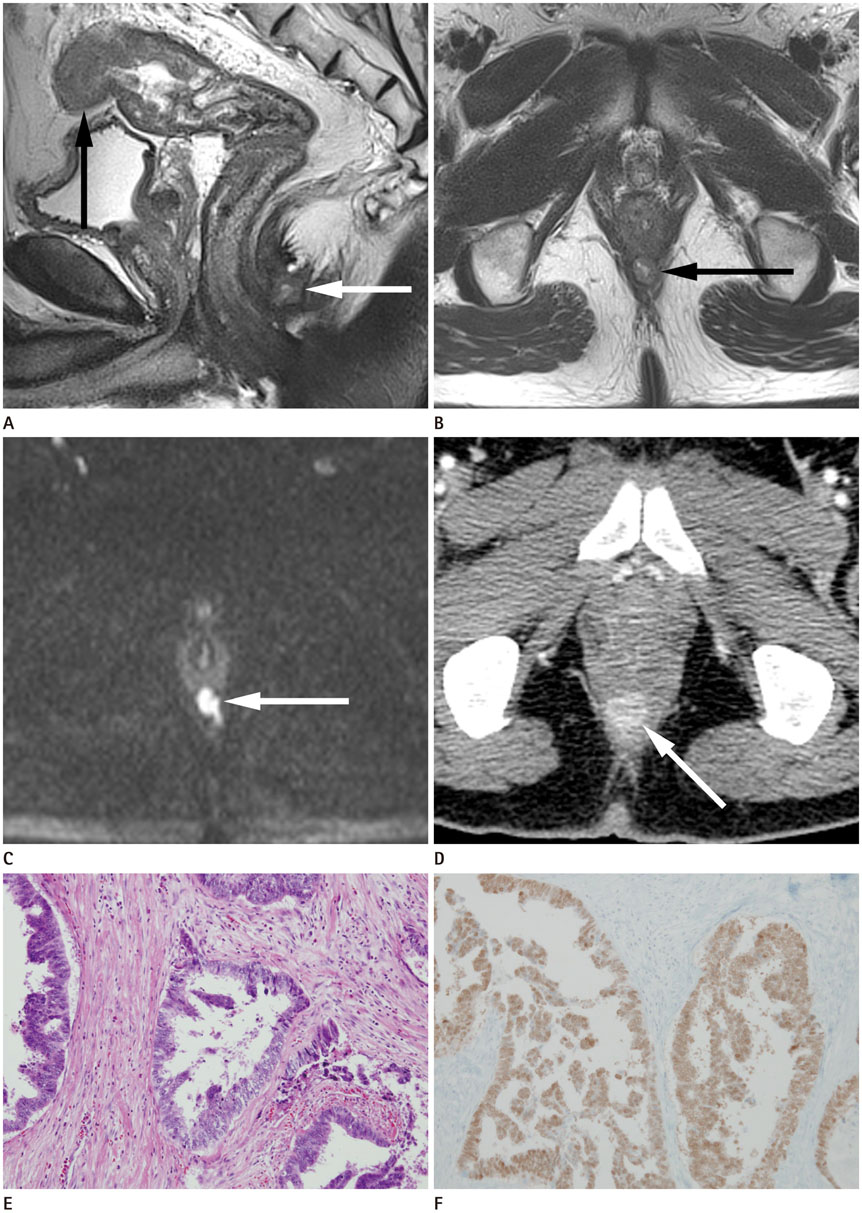J Korean Soc Radiol.
2016 Dec;75(6):501-507. 10.3348/jksr.2016.75.6.501.
Anal Metastasis Originating from Colorectal Cancer: Report of Two Cases
- Affiliations
-
- 1Department of Radiology and Research Institute of Radiological Science, Yonsei University College of Medicine, Seoul, Korea. jslim1@yuhs.ac
- 2Department of Pathology, Severance Hospital, Yonsei University College of Medicine, Seoul, Korea.
- KMID: 2360439
- DOI: http://doi.org/10.3348/jksr.2016.75.6.501
Abstract
- Anal metastasis from colorectal cancer rarely occurs, but it severely impairs the patient's quality of life, often requiring wide resection including the anal sphincter with permanent colostomy. This lesion can be misdiagnosed as a perianal fistula or an abscess, and it can be overlooked at the time of surgery because it is not included in the routine surgical extent of low anterior resection. We report two rare cases of anal metastasis from colorectal cancer. In both cases, perianal nodules with an internal solid portion were detected on preoperative rectal magnetic resonance imaging and additional local excisions of the anal lesions were performed during the process of treatment. Anal metastasis was pathologically confirmed by histology and immunohistochemical staining.
MeSH Terms
Figure
Reference
-
1. Guiss RL. The implantation of cancer cells within a fistula in ano: case report. Surgery. 1954; 36:136–139.2. Suh E, Traber PG. An intestine-specific homeobox gene regulates proliferation and differentiation. Mol Cell Biol. 1996; 16:619–625.3. Takahashi H, Ikeda M, Takemasa I, Mizushima T, Yamamoto H, Sekimoto M, et al. Anal metastasis of colorectal carcinoma origin: implications for diagnosis and treatment strategy. Dis Colon Rectum. 2011; 54:472–481.4. Ishiyama S, Inoue S, Kobayashi K, Sano Y, Kushida N, Yamazaki Y, et al. Implantation of rectal cancer in an anal fistula: report of a case. Surg Today. 2006; 36:747–749.5. Benjelloun el B, Aitalalim S, Chbani L, Mellouki I, Mazaz K, Aittaleb K. Rectosigmoid adenocarcinoma revealed by metastatic anal fistula. The visible part of the iceberg: a report of two cases with literature review. World J Surg Oncol. 2012; 10:209.6. Rosser C. The aetiology of anal cancer. Am J Surg. 1931; 11:328–333.7. Ramalingam P, Hart WR, Goldblum JR. Cytokeratin subset immunostaining in rectal adenocarcinoma and normal anal glands. Arch Pathol Lab Med. 2001; 125:1074–1077.8. Lisovsky M, Patel K, Cymes K, Chase D, Bhuiya T, Morgenstern N. Immunophenotypic characterization of anal gland carcinoma: loss of p63 and cytokeratin 5/6. Arch Pathol Lab Med. 2007; 131:1304–1311.9. Morris J, Spencer JA, Ambrose NS. MR imaging classification of perianal fistulas and its implications for patient management. Radiographics. 2000; 20:623–635. discussion 635-637.
- Full Text Links
- Actions
-
Cited
- CITED
-
- Close
- Share
- Similar articles
-
- Clinical Characteristics of Ovarian Metastasis from Colorectal Cancer
- Computed tomography of the rectal and anal cancer
- Significance of p53 Overexpression in the Metastasis of Colorectal Cancer
- Association of Human Papillomavirus with Human Colorectal Cancer
- Expression of Tumor Metastasis Related Genes in Korean Colorectal Cancers and Cell lines



